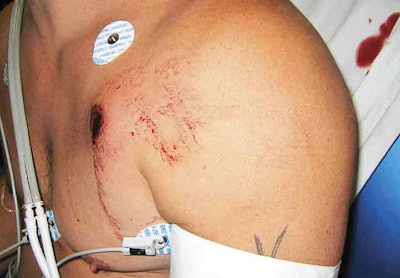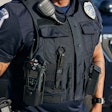 Photo courtesy of Sydney Vail
Photo courtesy of Sydney Vail
As a trauma surgeon and a tactical medical specialist, I am often asked by law enforcement officers what caliber and type of handgun ammunition offers the most stopping power. I can't answer that question. Let me explain why.
The ammunition most commonly carried by law enforcement officers is a hollow-point configuration or expanding full metal jacket bullet, typically in one of five calibers, including .38/.357, 9mm, .357 SIG, .40 S&W, and .45 ACP. Other calibers are used in some departments. But for the sake of this discussion, let's stick with the most common rounds. These handgun rounds perform very differently based on a number of key factors that I'd like to discuss.
At most agencies it is typical for either the rangemaster or lead firearms trainer to choose specific ammunition (caliber and/or bullet type) based on the results of ammunition being run through a series of ballistic tests, most commonly the FBI's ballistic laboratory testing. Marketing by ammunition companies also influences how agencies choose the specific ammunition for front line officers to carry.
Unfortunately, the information that agencies are using to choose the ammo for their officers is generally based on hype as well as the flawed standardized testing using ballistic gel and measurements of the depth of penetration into ballistic gel, degree of bullet expansion, and other factors. Usually, actual data on human body wound ballistics is not available to agencies when they are choosing ammo for their officers.
What is most unfortunate is that the testing of modern bullets does not give a complete picture of what a particular ammunition configuration will do in the human body to incapacitate it in a timely fashion, in other words, stopping power. The testing results "infer" or "simulate" what is believed to happen in the human body, but I can tell you that from my experience operating on gunshot patients that this just is not the case.
So back to the question at hand about determining stopping power. If you are expecting me to tell you which brand and which bullet caliber and type to use for the best or most reliable stopping power, you are going to be disappointed. But I will tell you about the factors that determine stopping power.
Kinetic Energy
Most officers think that a larger bullet and higher velocity equal more "kinetic" energy, yielding more stopping power than a smaller bullet with the same velocity. Here's the reality:
We know that the equation for kinetic energy is KE = ½mv2 (KE is kinetic energy, m is mass of object, and v2 is velocity squared). This equation tells us how much energy will be derived from a combination of bullet grain weight and muzzle velocity.
Now we need to go back a step and define stopping power. Is it the ability of a particular ammunition to:
- Immediately incapacitate a threat?
- Eventually incapacitate a threat?
- Slow down a threat?
- Render a person less able to remain a threat?
- Knock the threat to the ground?
I believe the definition of stopping power should be a particular ammunition's effectiveness to render a person unable to offer resistance or remain a threat to the officer, an intended victim, or self.
So how does ammunition accomplish this? You have two options. You can use a really large round at very high velocity like the 30mm cannon rounds from an Apache helicopter's M230 Chain Gun, which produces substantial kinetic energy, or you can place your shot where it has the most effect. Obviously, shot placement is the only realistic option for a law enforcement officer.
A .40 caliber bullet shot into the shirtless torso of a person causes a degree of injury due to the body absorbing the bullet's energy and dispersing it in front of and around the path of the bullet. The projectile also tears through the tissue. This means that the kinetic energy of this typically low-velocity (less than 1,500 feet per second) bullet will create both a permanent cavity and to a much lesser extent a temporary cavity.
But does this ammunition have acceptable stopping power? Only if it hits a vital structure that would "stop" the target from continuing the fight.
The Target Variable
Consider that the same ammunition shot into the torso of an officer wearing a ballistic vest involves the same forces, but they are dispersed over a greater surface area in order to dissipate those forces, which, hopefully, prevents penetration of the body and allows the officer to continue in the fight.
So is the stopping power the same or different for these two scenarios? The kinetic energy is the same, the tissue injury is different.
Another way to look at this is to think about a bowling ball as a projectile and how it might perform in two different scenarios. If someone shoots it out of a cannon into a brick wall, the large mass and high velocity will likely result in a significant hole in that wall. But if the same bowling ball is shot out of a cannon into a strong net made of Kevlar, it will likely have all of its energy taken up by the net and not allow penetration. It has the same energy to lose in its intended target but different targets yield different results. A bowling ball fired from a cannon has high kinetic energy and excellent stopping power that far exceeds any ammo you could carry on duty, but the effect it has on the target is still determined by shot placement and the nature of the target.
Real Gunshot Wounds
The point here is that no single ammunition that is typically used by law enforcement officers today can reliably claim to have superior stopping power.
I have seen a .22 caliber bullet completely incapacitate someone and a .45 ACP fail to achieve that result. People and animals shot with 10mm rounds and .357 SIG rounds have continued to run from the police. I have been on scene as a tactical medical provider when a suicidal person shot himself in the head with a .45 Colt round resulting in instant death. And I have seen the same results in suicides that used smaller calibers, including .22, .25, and .32. I have also seen people hit with 9mm, .40, and .45 without so much as staggering or slowing their verbal or physical activities.
So we come back to the original question: Which ammunition has the best stopping power? I can't answer that question. What I can say is that you should look for ammunition that reliably lives up to its claims of penetration and expansion but don't believe that these two factors alone are related to stopping power.
The ultimate stopping power rests with your training with your weapon system. Accurate hits in any reasonable caliber will "stop" a person if that person has experienced enough brain or spinal cord damage to interrupt regular neurologic impulses from reaching vital areas of the body or the person has hemorrhaged enough blood to lower his or her blood pressure where the brain no longer is able to function well. You can also stop a person if a major bone shatters after a bullet injures it, but does that stop the fight?
Stopping power is a marketing tool and should be dropped from our discussions of ballistic performance until such time as ammunition effectiveness is measured by more means than just the results of gelatin and barrier tests. When ammunition companies or regulatory agencies begin to use computer simulations, simulant tests, animal models, autopsy results, and trauma surgeon operation reports with hospital summaries to determine the effectiveness of their products, then we will know which ammunition can be labeled as having the "best stopping power." And this claim will be based on scientific data rather than incomplete ballistic testing.
Until then, shot placement with any commercially available ammunition will offer you the best chance of maximizing your duty ammunition's stopping power.
Sydney Vail MD, FACS, is an associate professor of surgery on the trauma faculty at Penn State Milton S. Hershey Medical Center and Penn State College of Medicine in Hershey, Pa. He also serves as director of tactical medicine programs for the Arizona Department of Public Safety and Maricopa County (Ariz.) Sheriff's Office SWAT teams.















